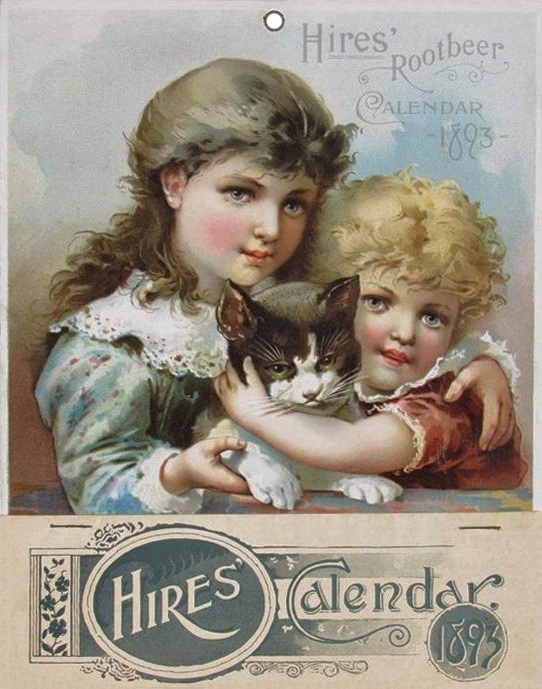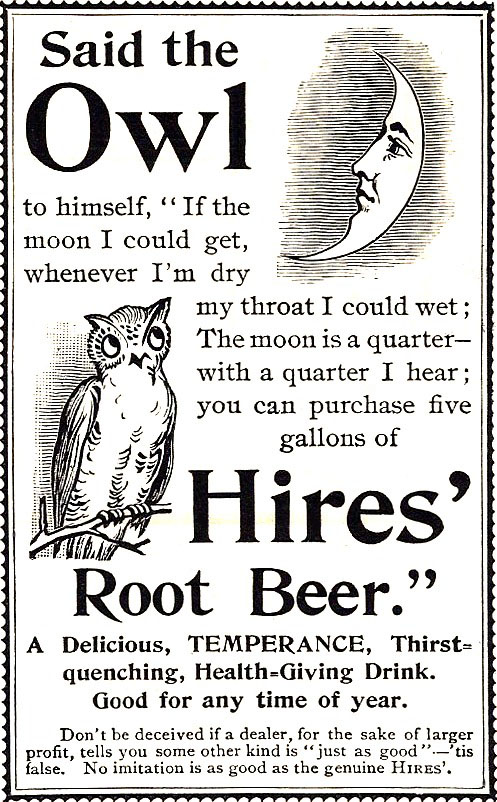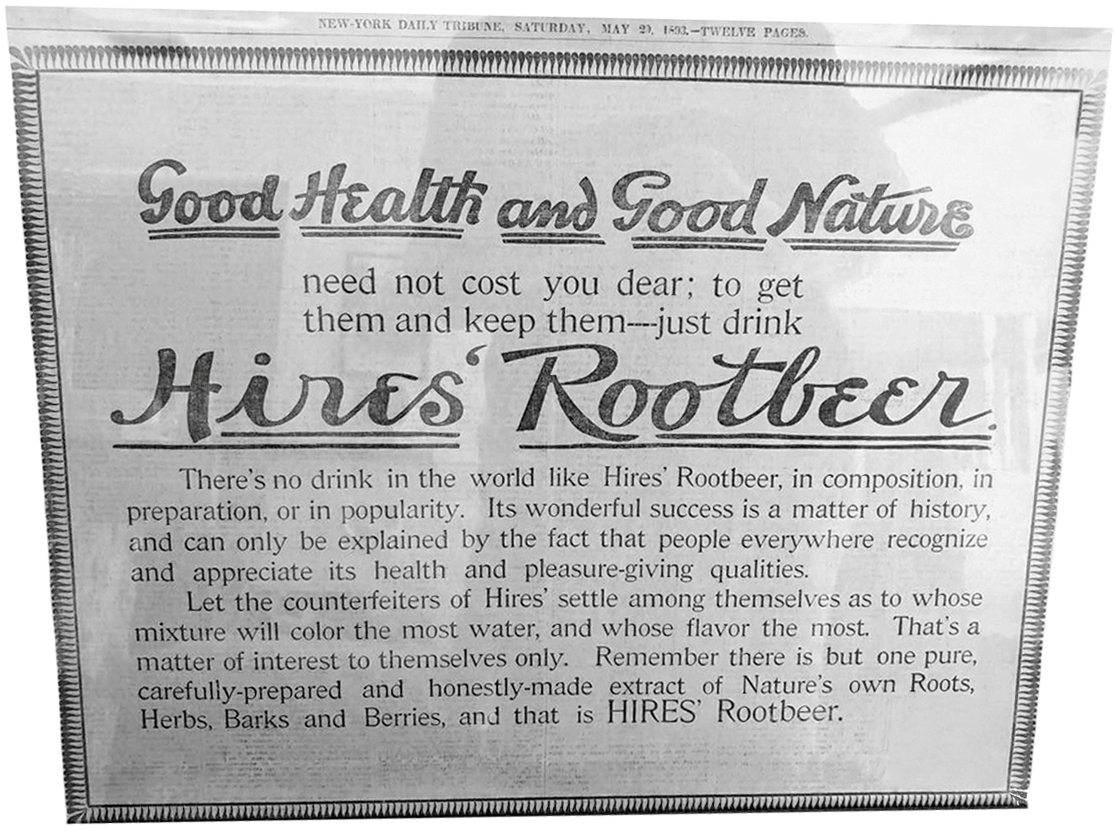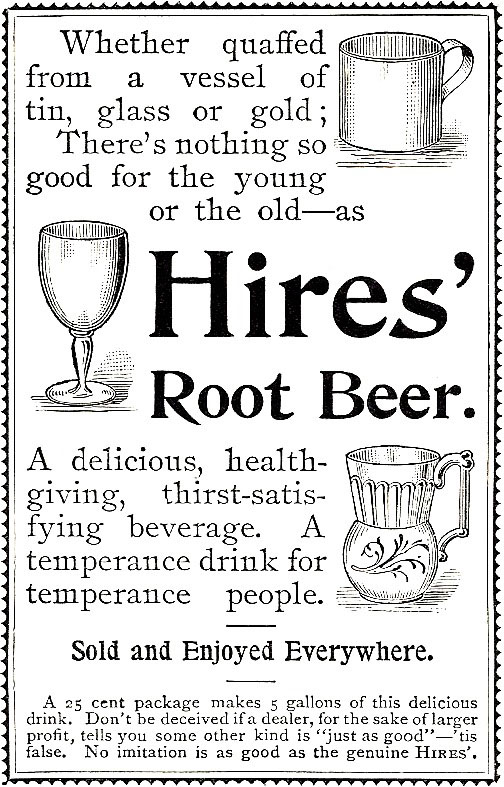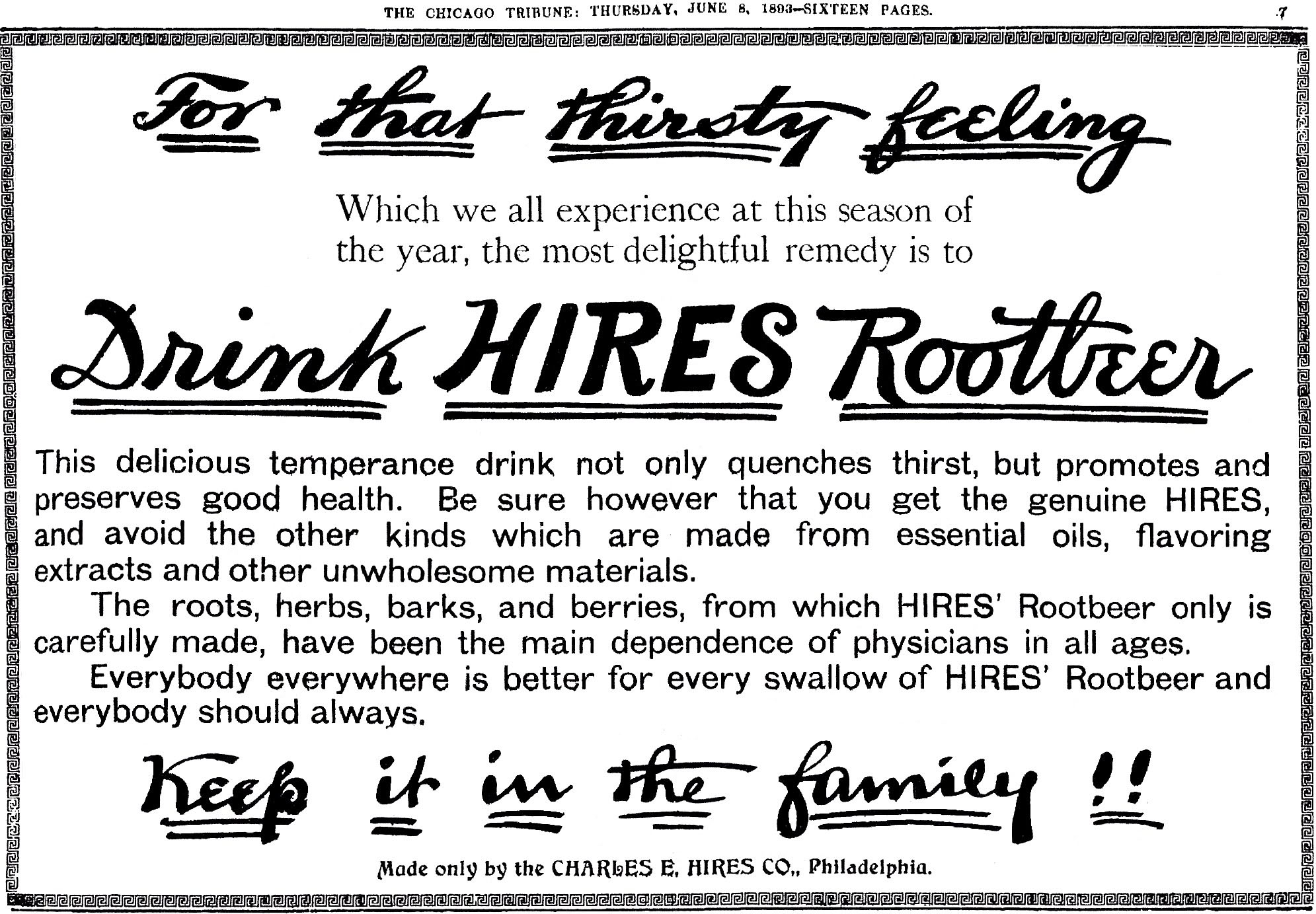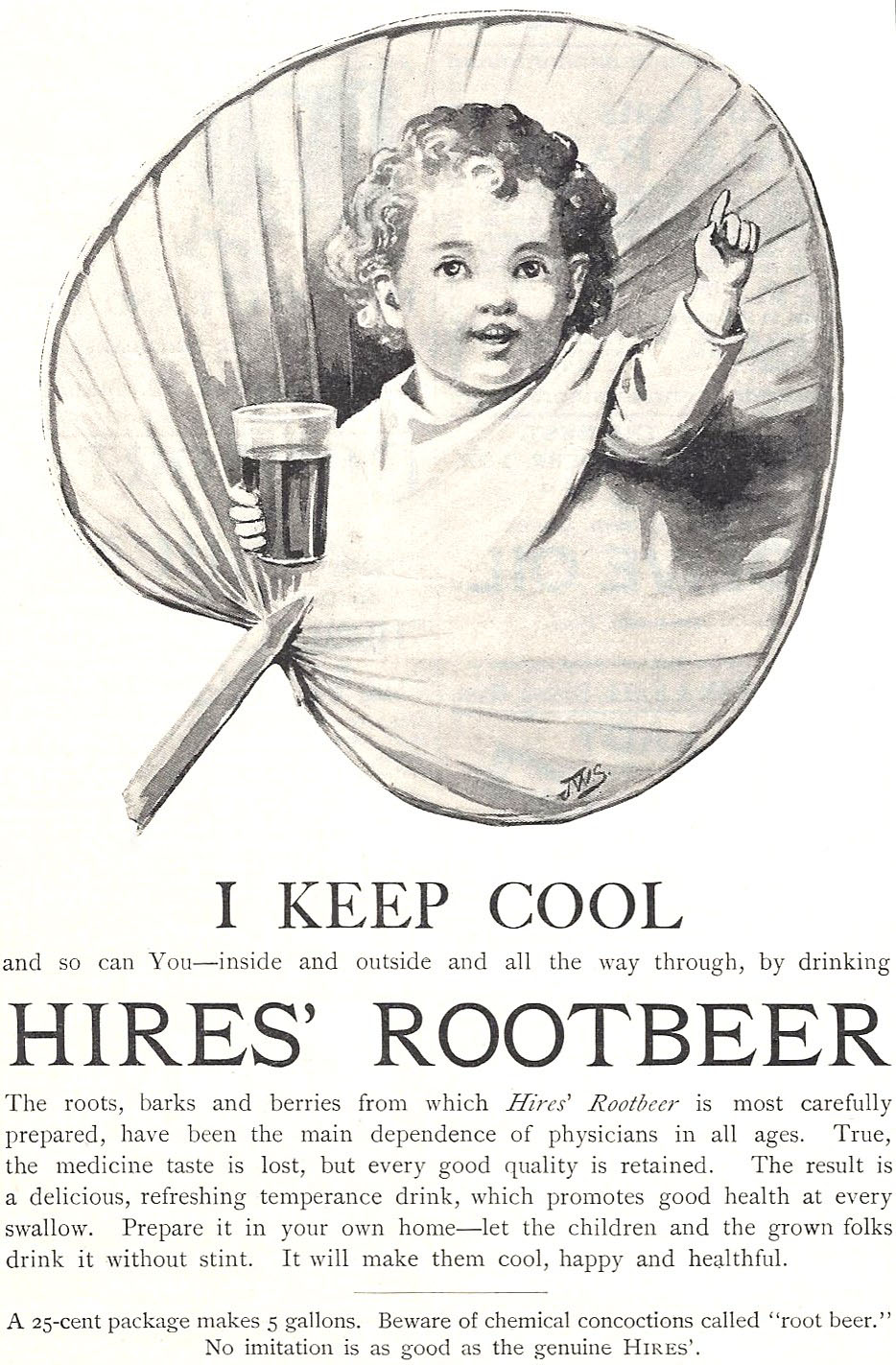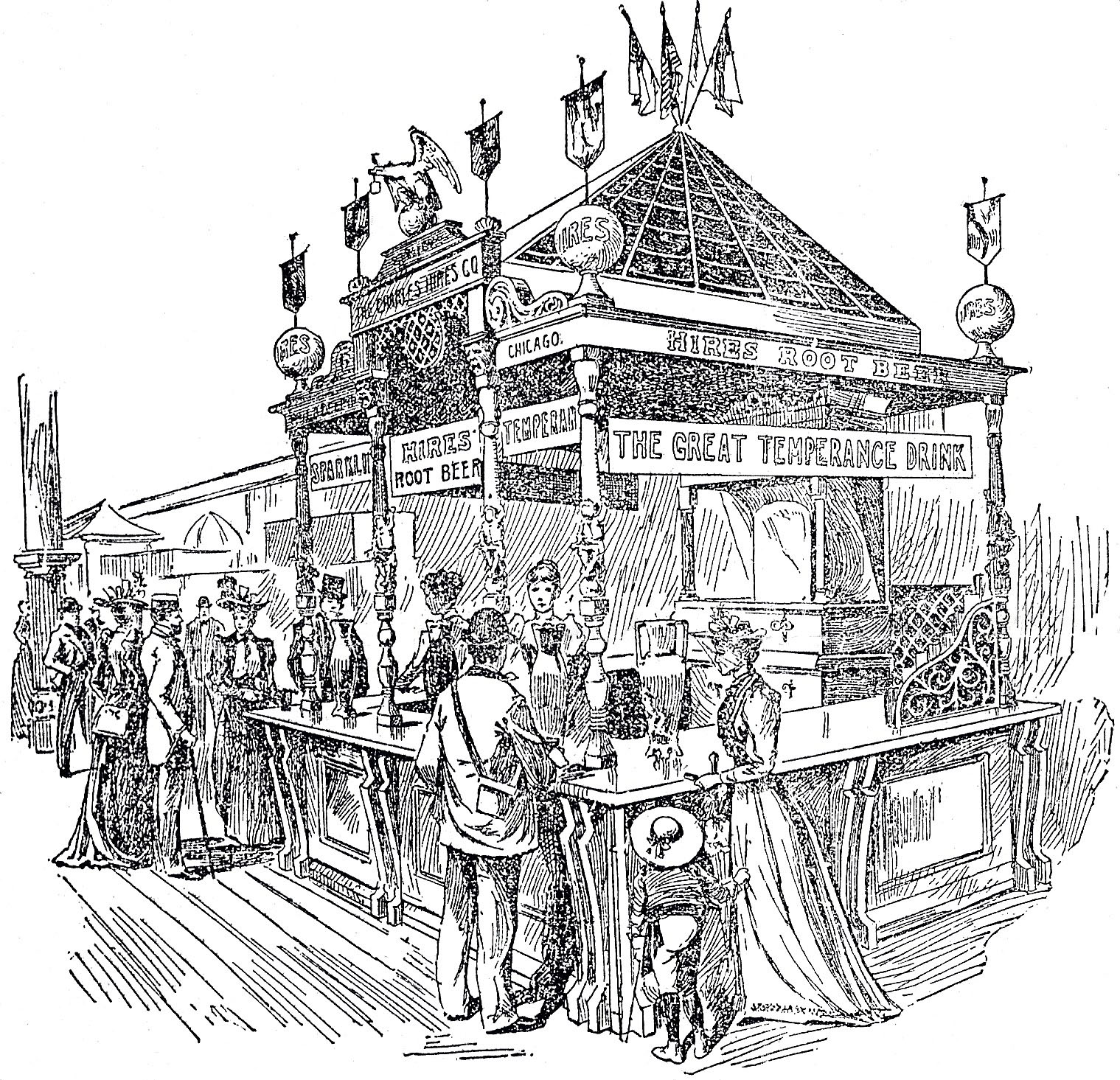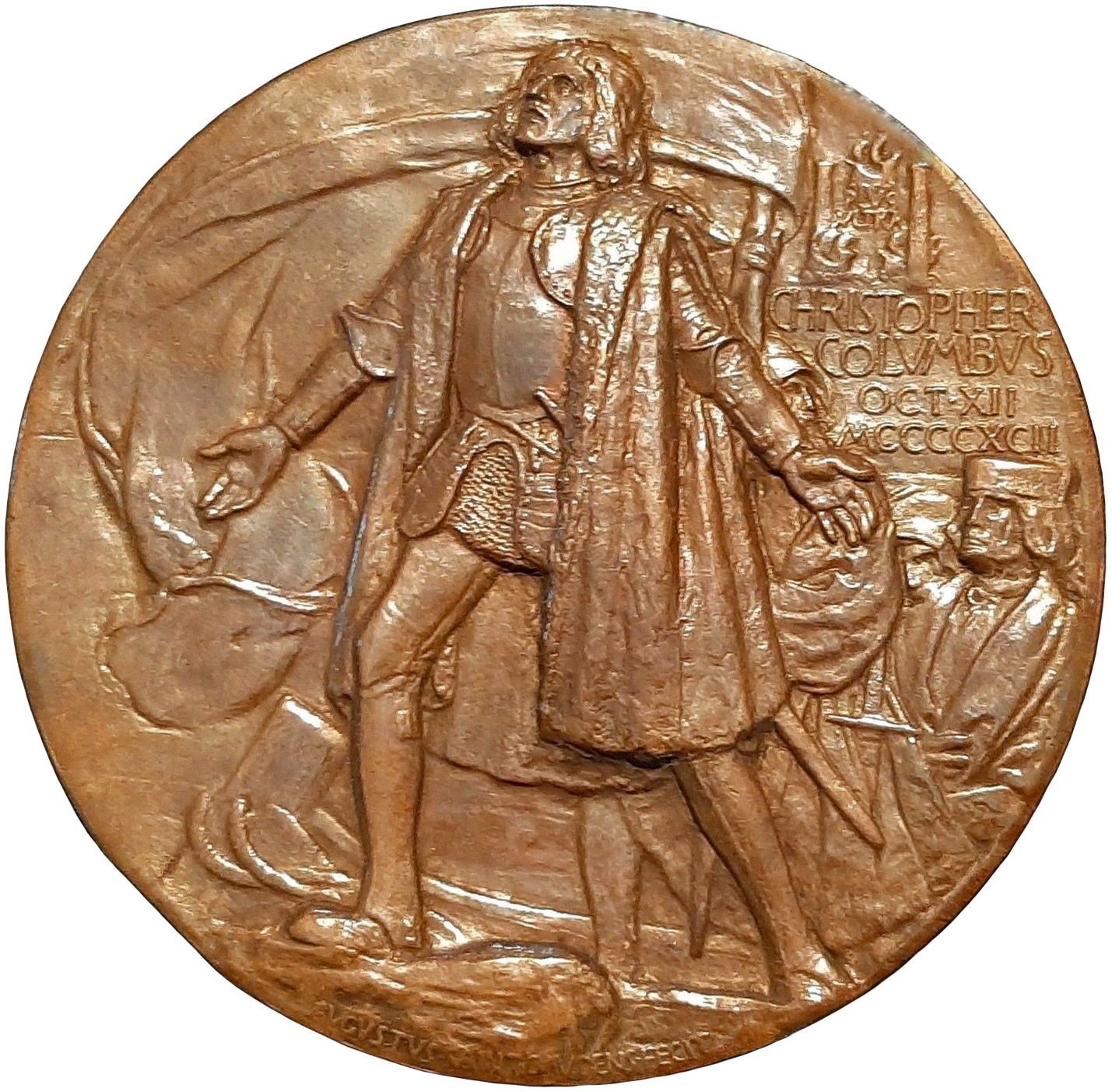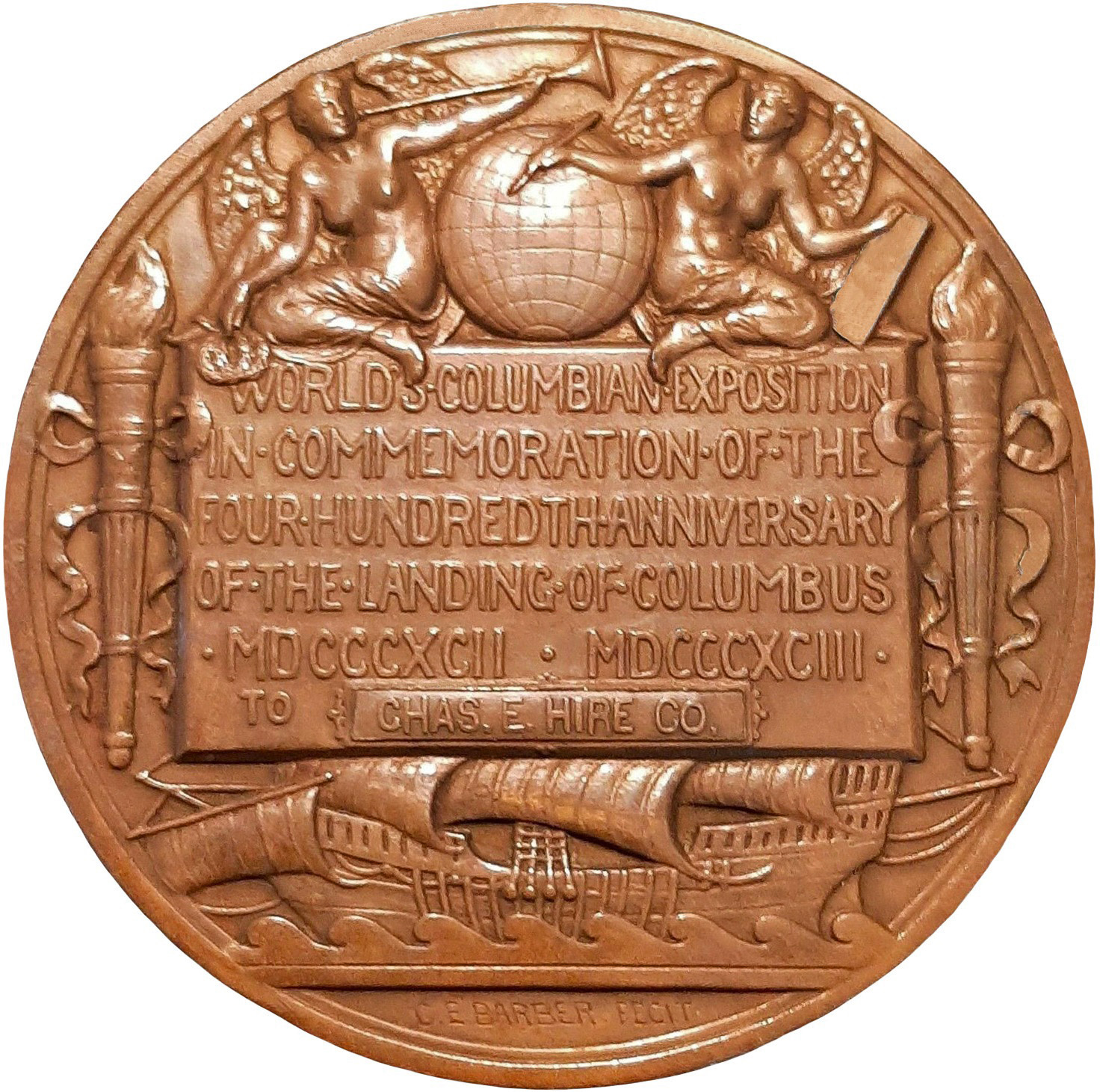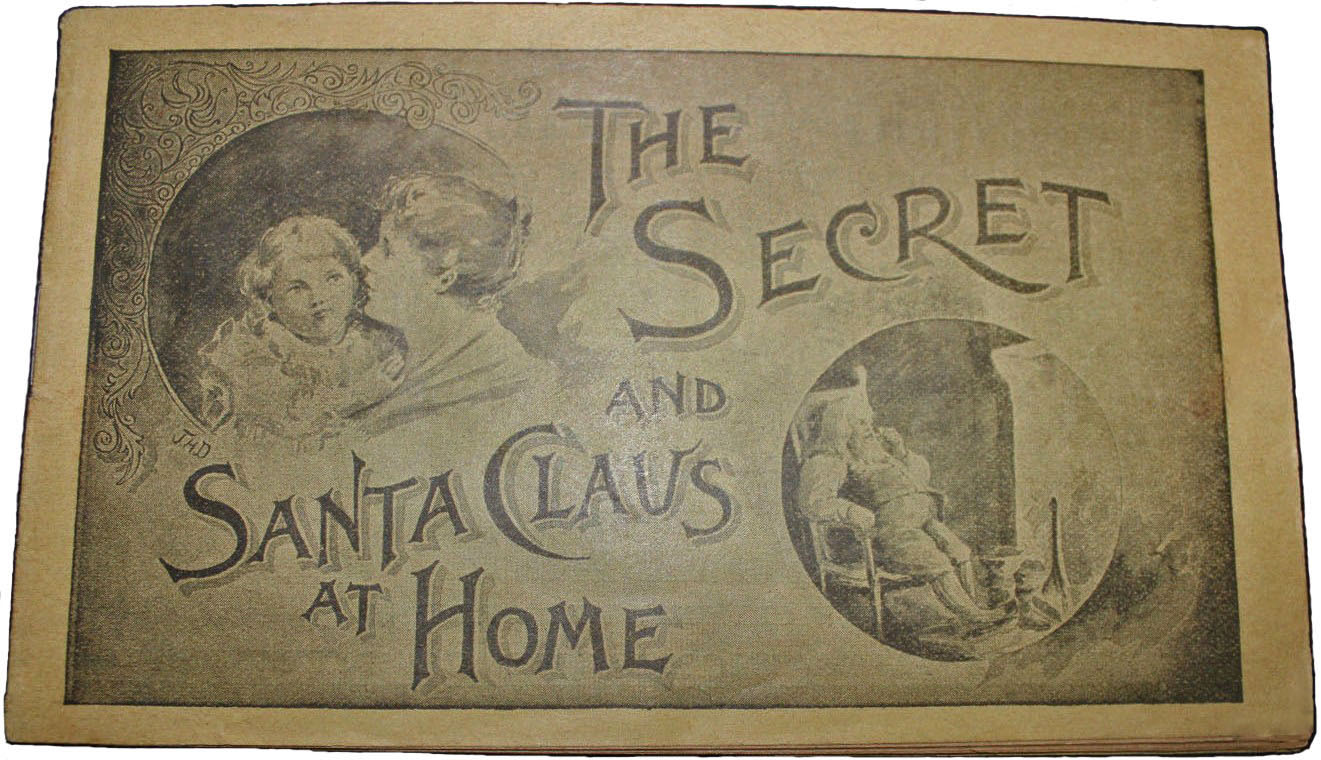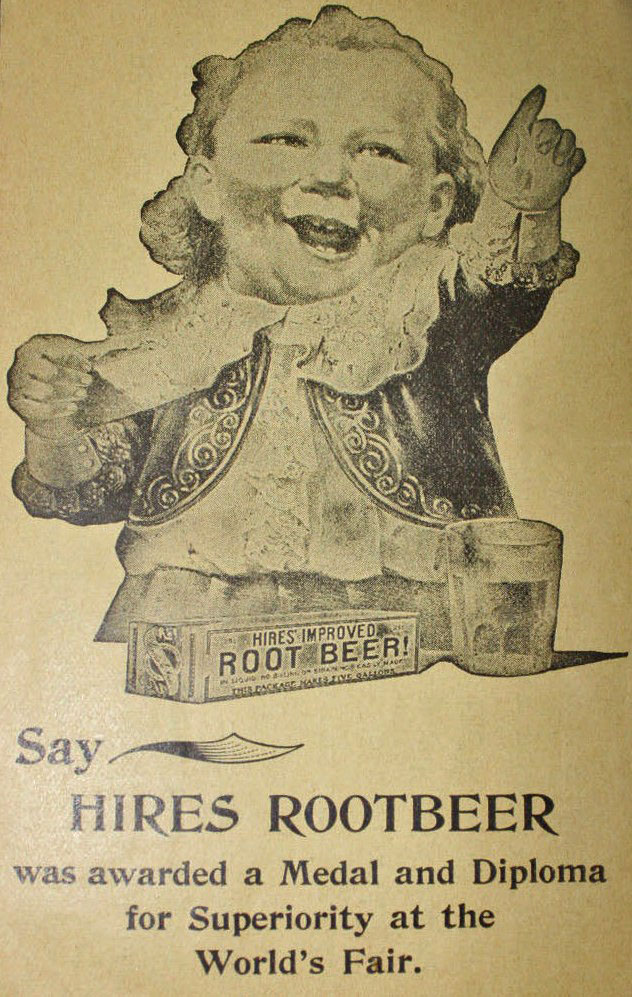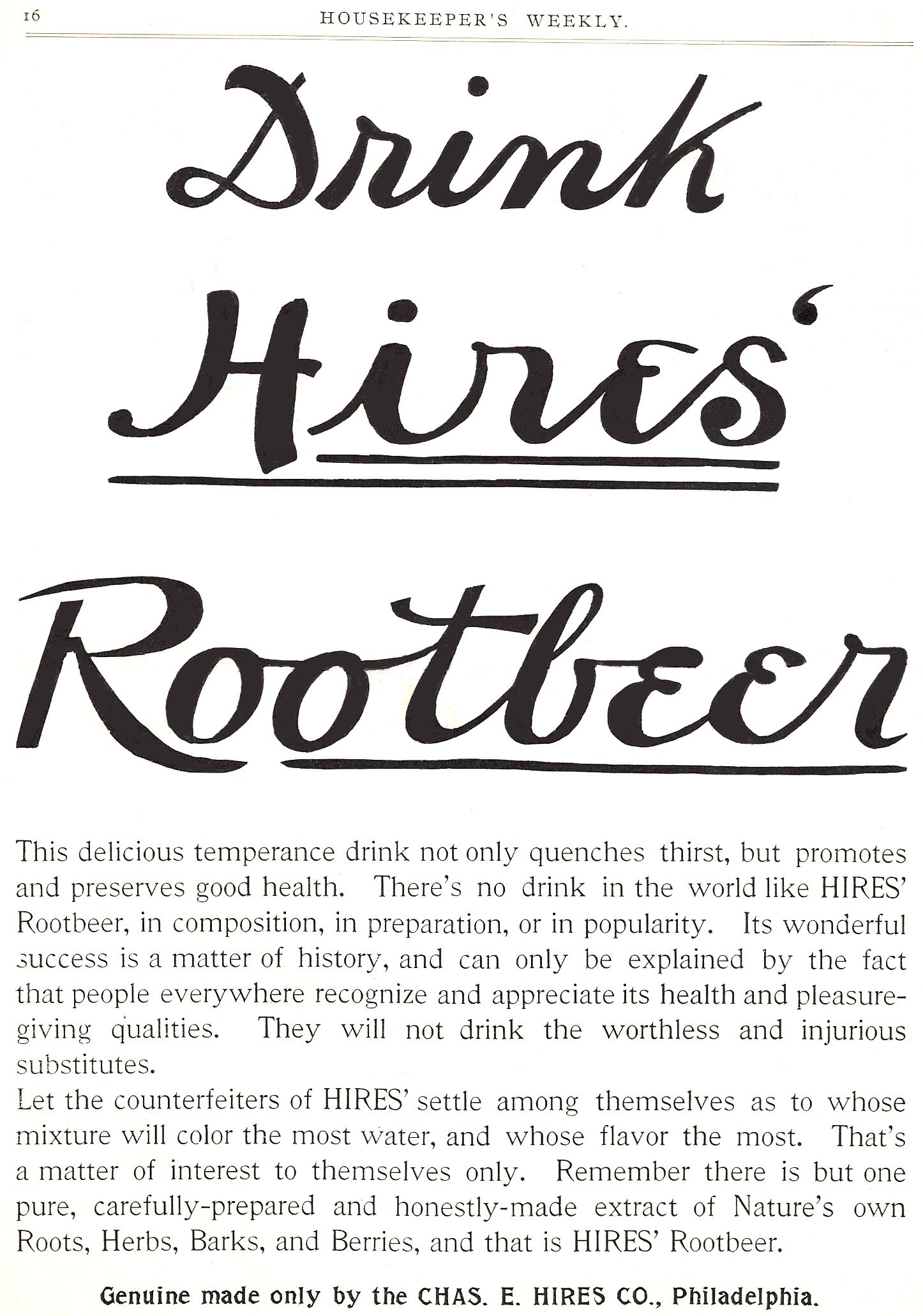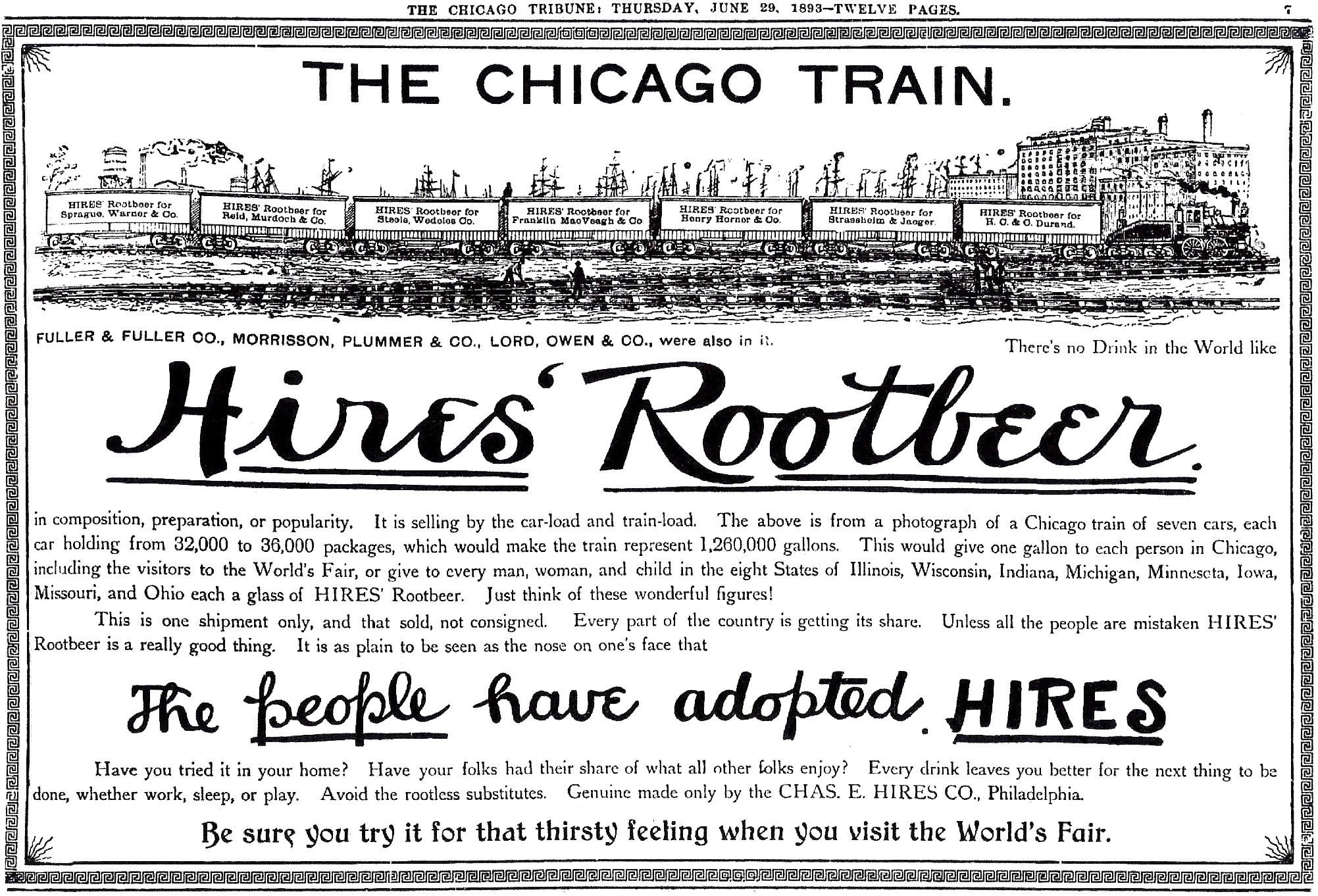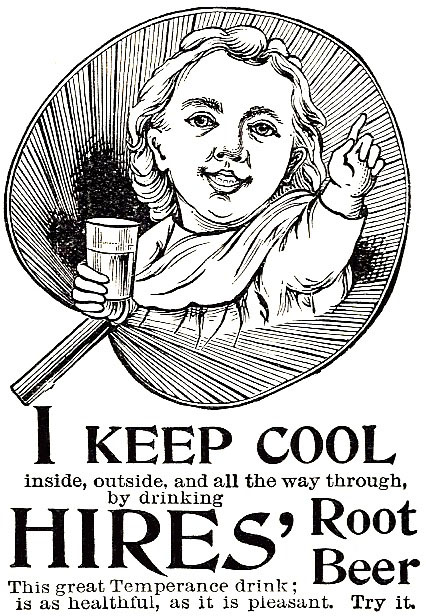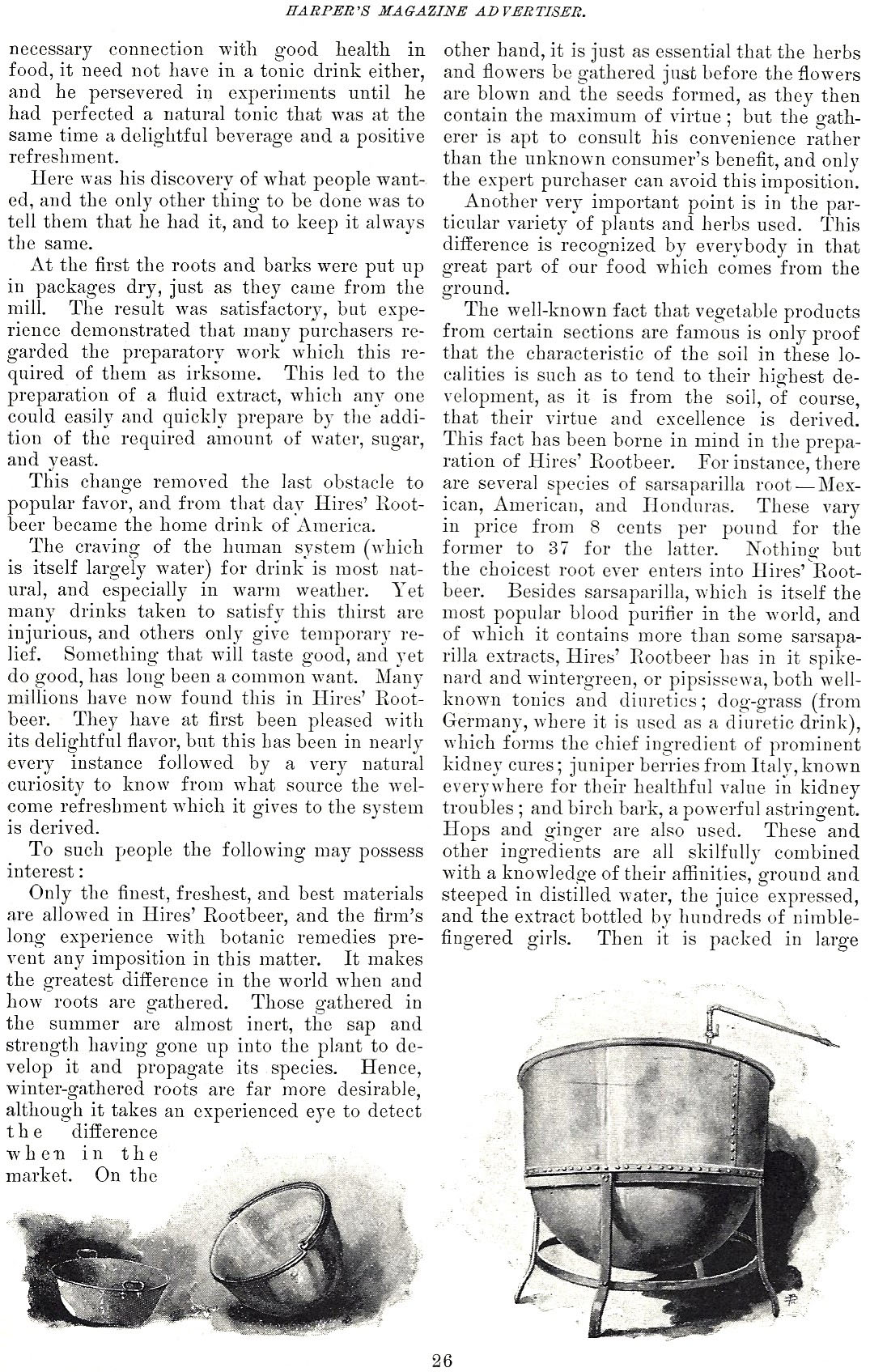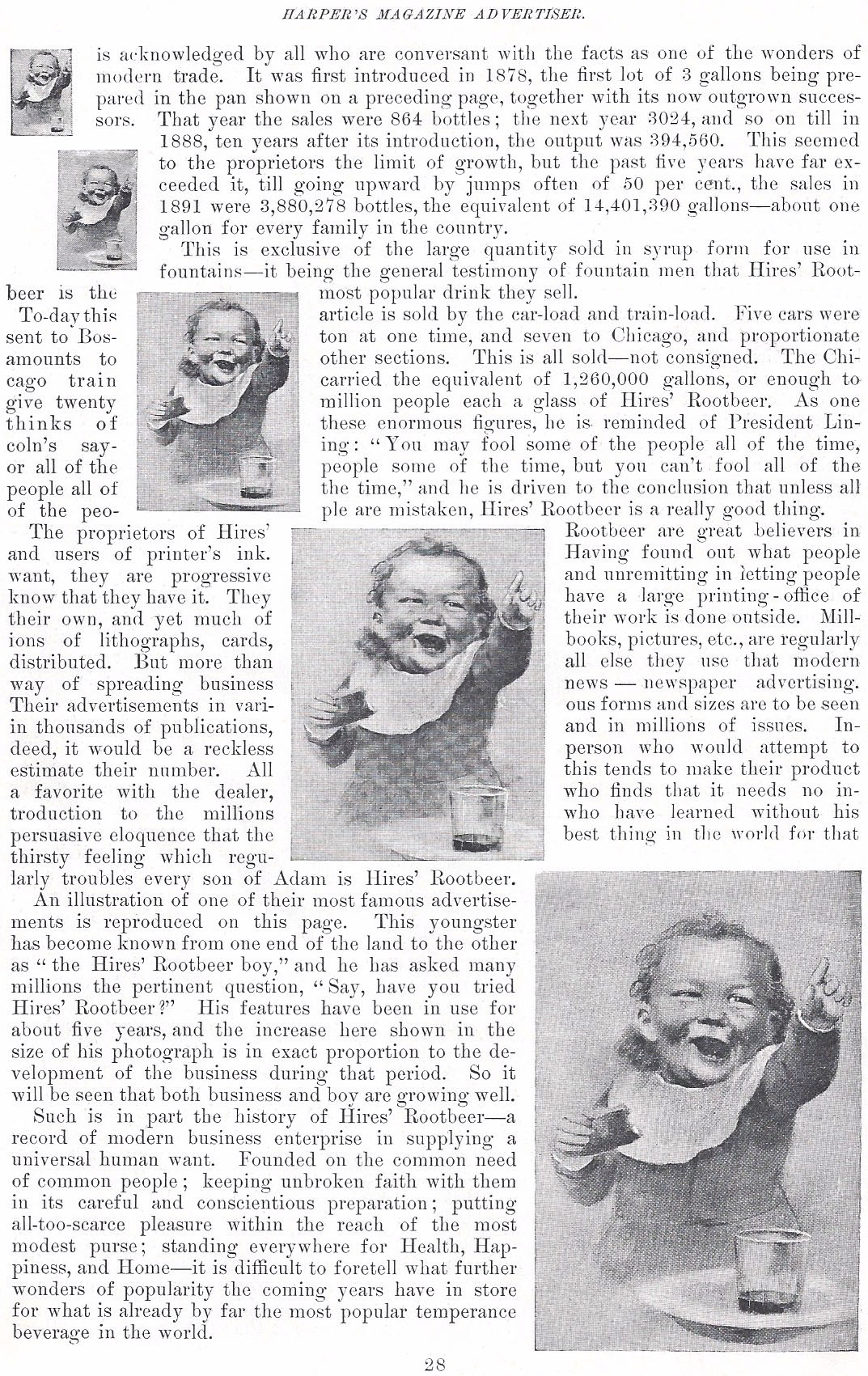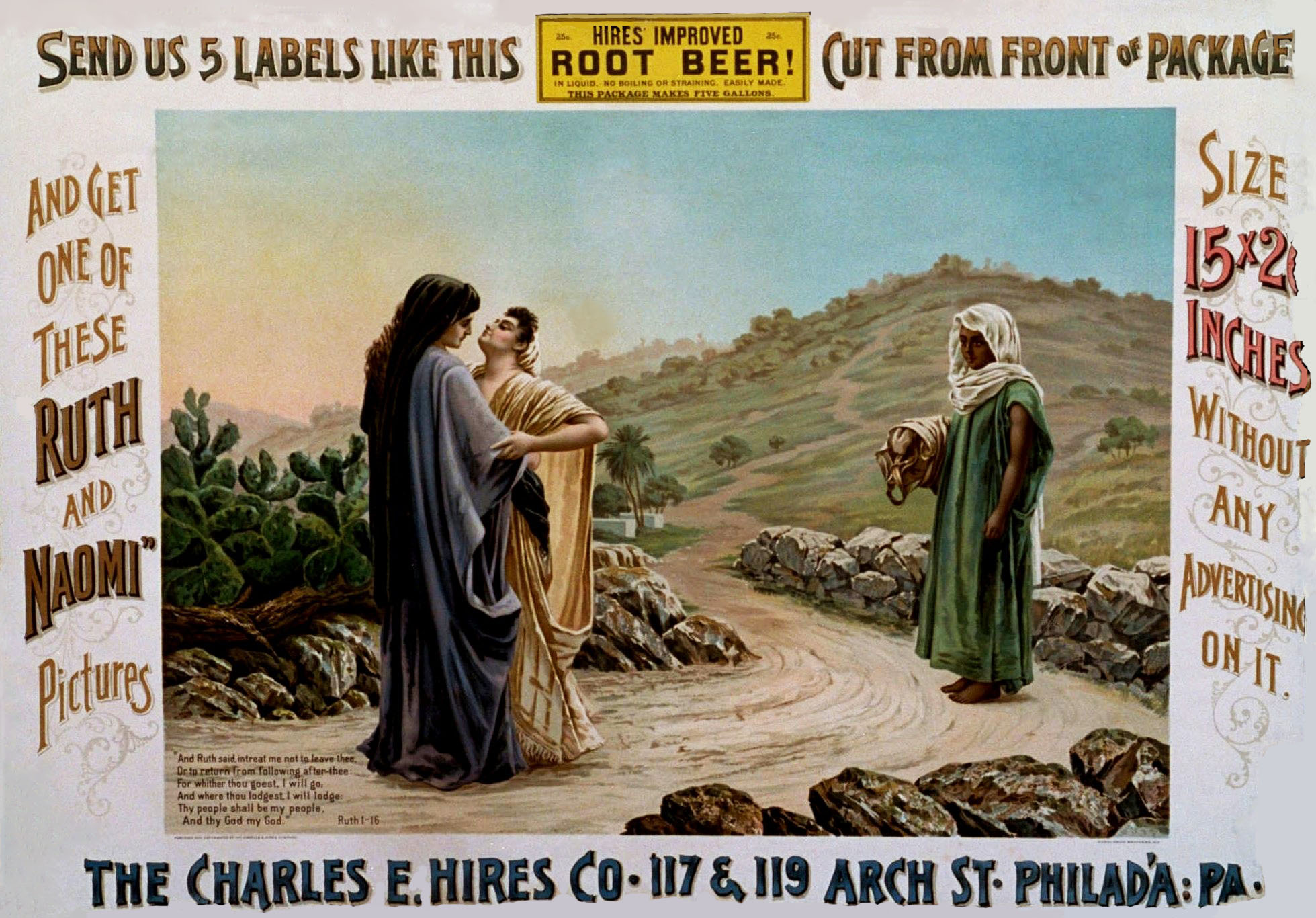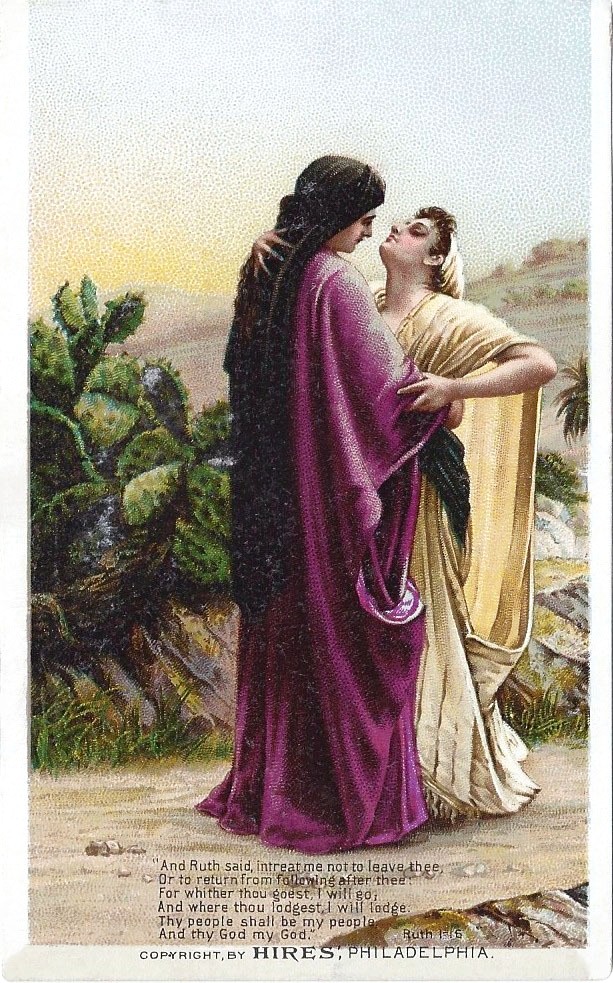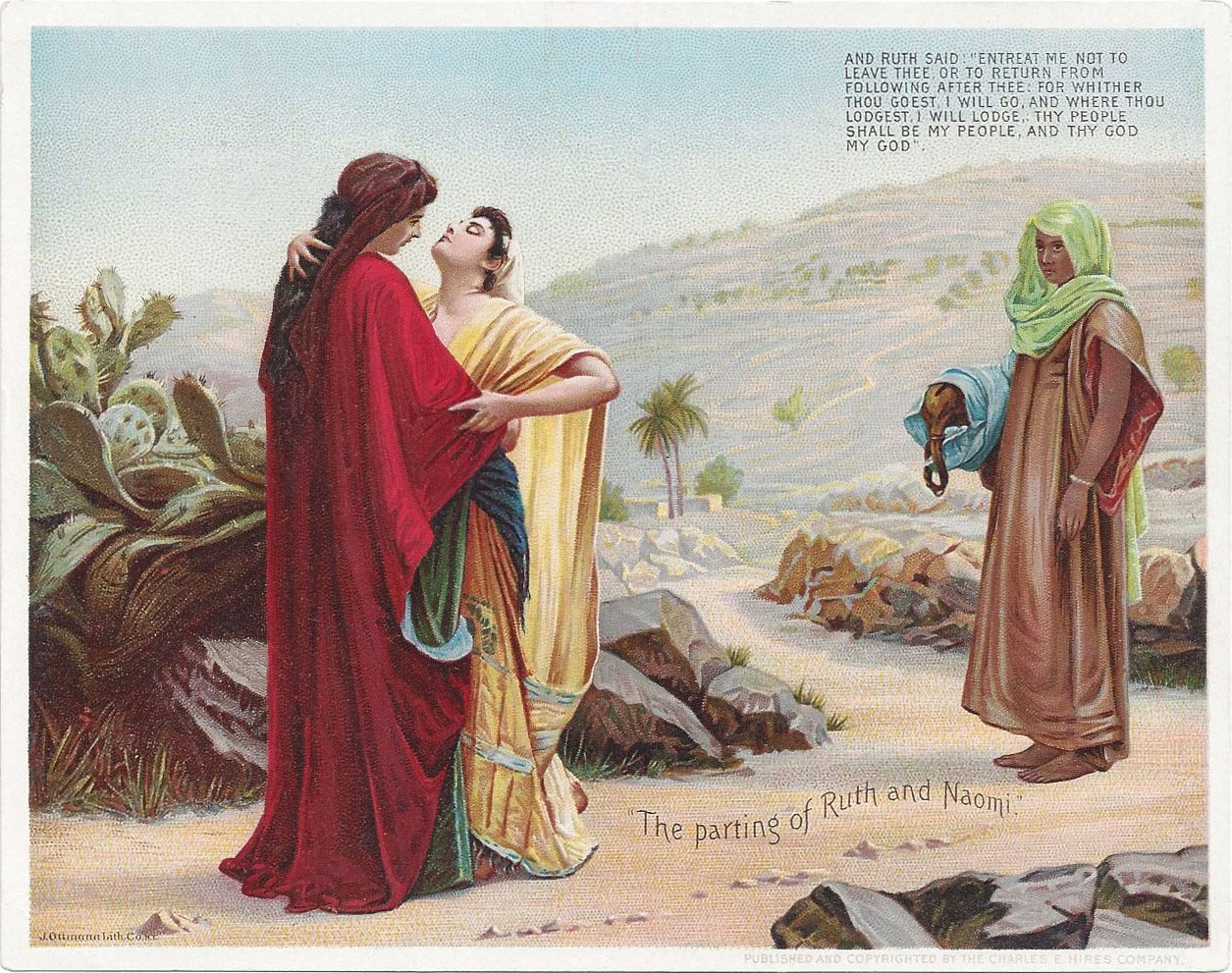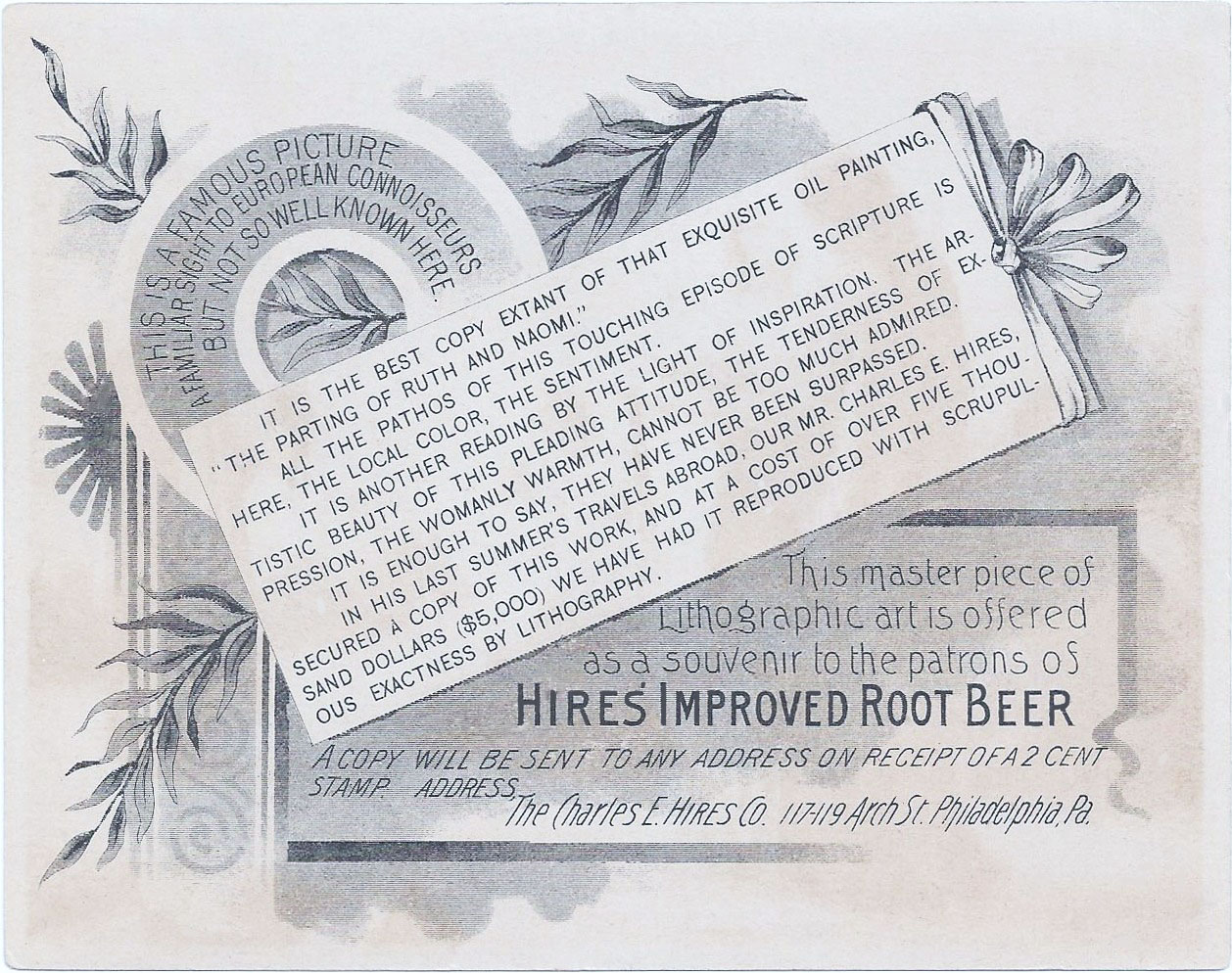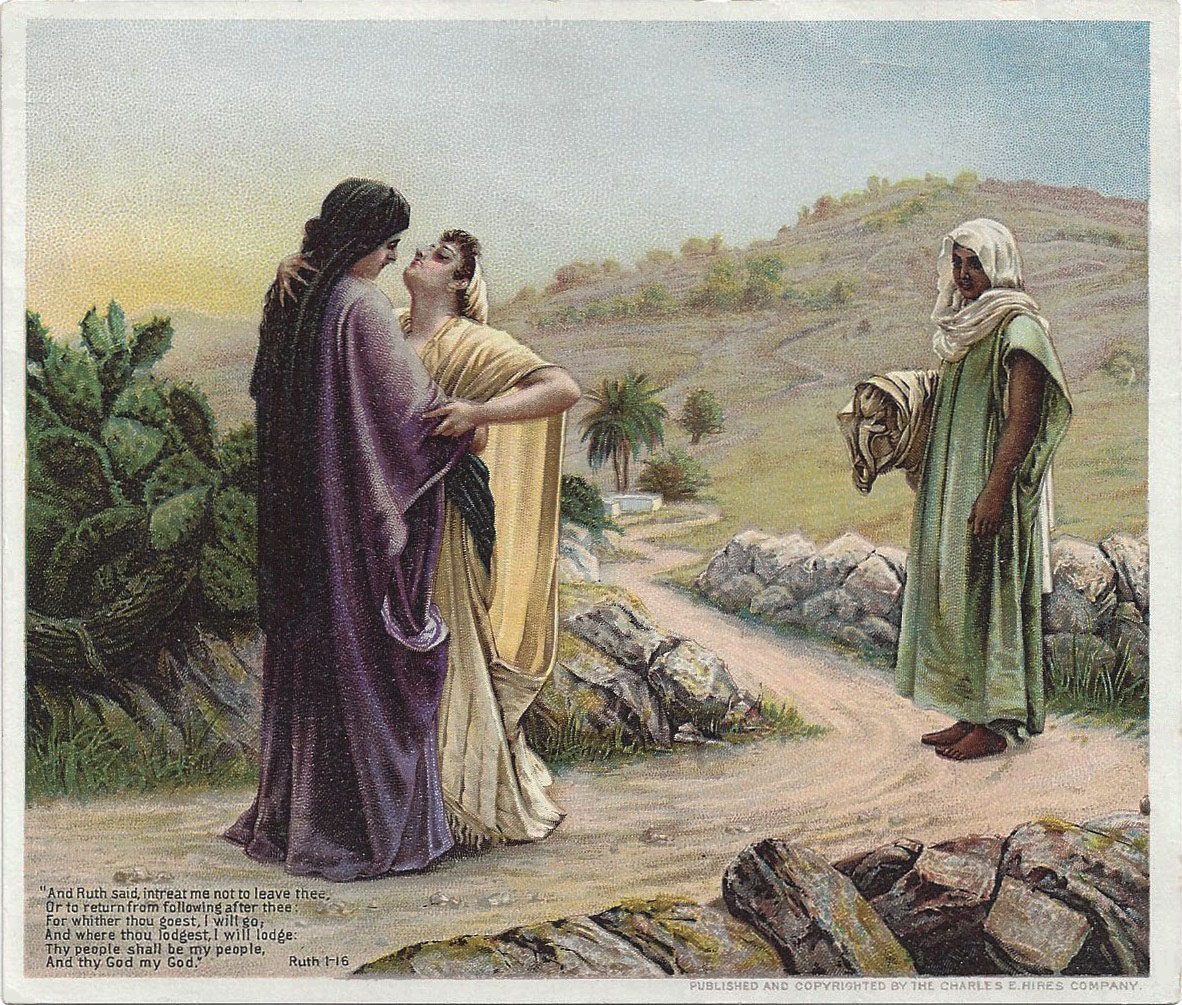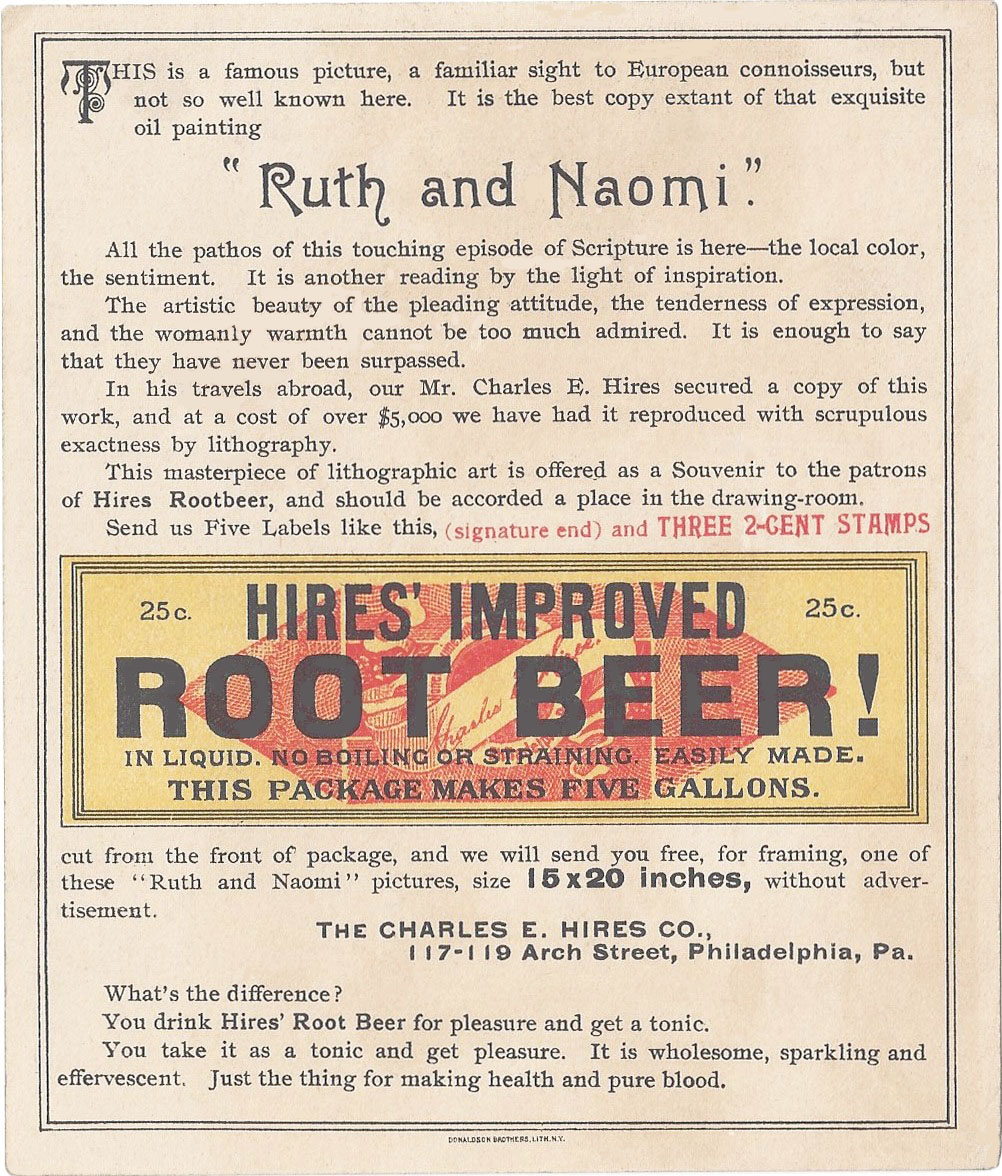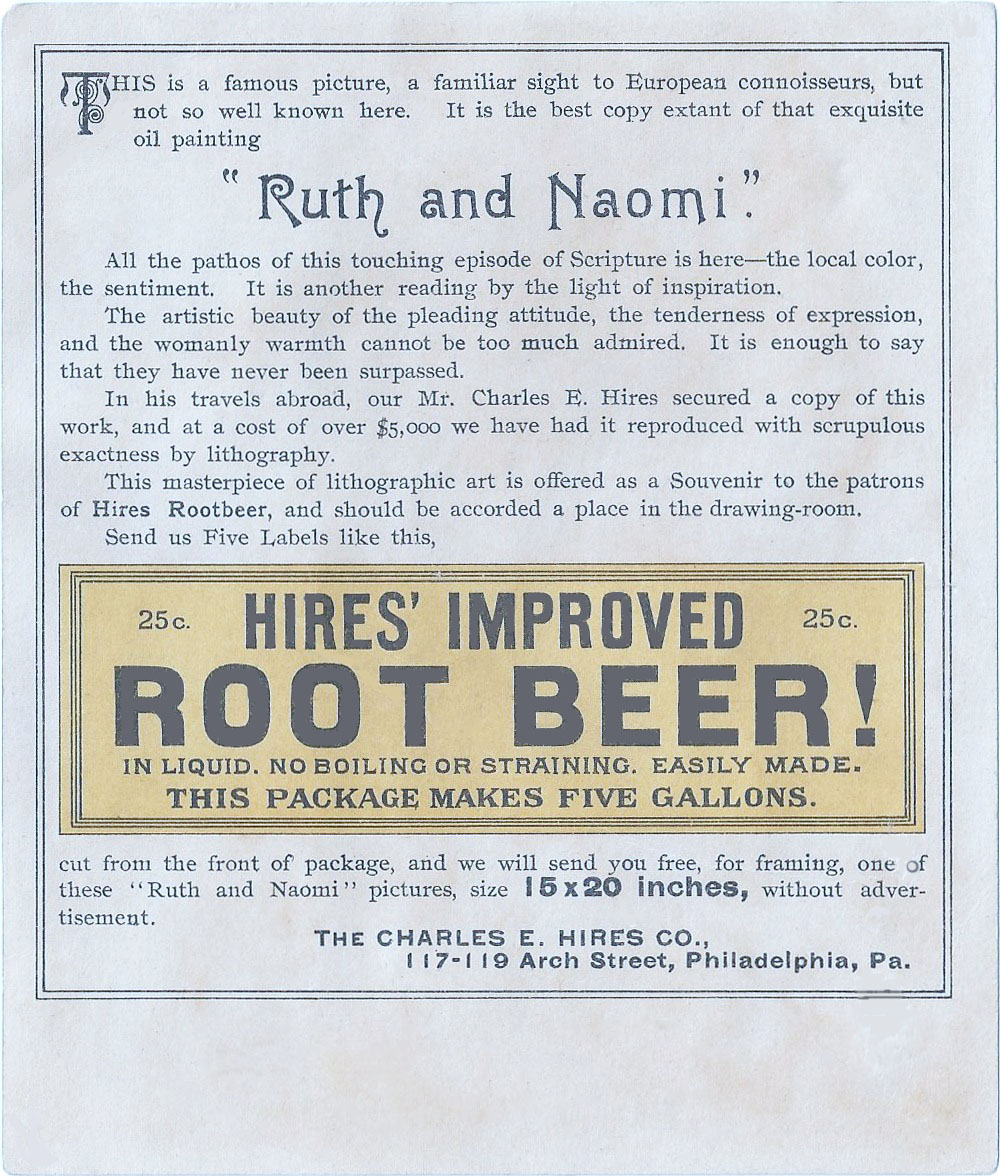1893
IT HAPPENED IN…1893
Foreign investors grew disillusioned with the
U.S. economy, withdrew capital, and triggered a worldwide financial
depression. Farm
foreclosures increased, businesses and railroads went into
receivership, the steel industry declined, and unemployment rose.
When stock prices dropped, there was a financial panic.
Over 500 banks and 15,000 companies eventually failed.
The World’s Columbian Exposition, popularly known
as the Chicago World’s Fair, marked the 400th anniversary
of Columbus’ discovery of America.
Exhibits from 72 countries attracted over 20 million
visitors. George
Ferris’ revolving steel wheel was a major attraction.
The Great Northern Railway, the northernmost
transcontinental route, was completed.
Henry Ford completed construction of his first
successful gasoline engine.
(Figure 1893-01, Hires’ 1893
calendar, front)
(Figure 1893-01, Hires’ 1893 calendar, back)
This flyer published in early 1893 touted strong
sales of Hires’ Root Beer in 1892:
(Figure 1893-02, paper flyer,
4.5” x 7.0”)
This small advertisement was placed on the front page of the March 8, 1893 edition of the Lebanon Courier and Semi-Weekly Report newspaper in Lebanon, Pennsylvania.
(Figure 1893-02.5, Lebanon
Courier and Semi-Weekly Report, March 8, 1893)
Slightly different versions of this advertisement were customized for specific audiences. This first example features the word TEMPERANCE in all capital letters, and the standard warning to be wary of imitators.
(Figure
1893-03, St.
Nicholas magazine, May 1893)
This version has the word TEMPERANCE in upper/lower case letters, and no warning about imitators.
(Figure
1893-03.5, magazine advertisement)
(Figure
1893-03.7, New York Daily Tribune, May 20, 1893)
(Figure
1893-03.8, New York Daily Tribune, May 27, 1893)
(Figure
1893-04, Liberty,
May 1893, and
St. Nicholas, June 1893)
(Figure 1893-05, Century and The Chautauquan magazines, June 1893)
An abbreviated version of the same advertisement without the warning about dealer deceit was placed in other magazines during June, 1893:
(Figure 1893-05.5, The Household and Home magazines, June 1893)
(Figure 1893-06, Century and The Chautauquan magazines, June 1893)
Note the child depicted in this magazine advertisement is not the Hires Boy:
(Figure
1893-07, The
Ladies’ Home Journal, June 1893)
Wednesday morning, June 14, 1893, page 18 of the 20 page Philadelphia
Public Ledger newspaper
featured a full page article about Charles E. Hires and Hires Root Beer.
Today such an article would likely be considered an
“infomercial,” as the author wasn’t identified and The Charles E. Hires
Company was heavily involved in the composition of the content.
Nonetheless, the article is a wonderful source of historical
information and provides a detailed “snapshot” of Hires Company
activities in 1893.
Selected excerpts have been cited in other chapters based on references
to specific years, time periods, events, and developments.
Here is the article in its entirety:
DO YOU DRINK?
A DELICIOUS
SUMMER BEVERAGE FOR ALL
AT THE WORLD’S FAIR
THE GENESIS OF THE EXTRACT OF HIRES’
ROOTBEER.
RISE OF A PHILADELPHIA HOUSE
STORY OF A SELF-MADE MAN AND HOW HE
WON SUCCESS.
Although Hires’ Rootbeer is, perhaps, the best
advertised beverage in the United States, and people have heard of it
all over the country, many never tasted its delicious flavor until they
drank it at the World’s Fair in Chicago.
Every day crowds are to be seen surging around the booth in the
Agricultural Building, awaiting their turn to get a sample glass, and
then depart happier for the taste.
There are very many larger exhibits in the
Agricultural Building, but it is doubtful if there is any display in it
that is more attractive.
And it is not simply attractive because two pretty girls, tidily
dressed, draw the foaming, tasteful rootbeer and hand it to all who want
to try the great temperance drink, but the exhibit itself is an
attraction. It is not one
that a visitor would hastily pass, bestowing only a glance, for the
booth has been prepared with care and a nice attention to artistic
effect.
The Handsome Pavilion.
When it is considered that $3000 have been expended
upon the fitting of the booth, which is about 12 feet square, and the
fountain from which the healthful rootbeer is flowed, some idea may be
gained of its elaborate character.
However, this is not offensive to good taste, for it does not
strike you that anything has been overdone, and consequently it has the
charm of pleasing. The
exhibit consists of a solid oak counter, panelled and measured off with
carved brackets. A
Tennessee marble top covers this, and above it rises a canopy about 12
feet high. This is
supported in front by four elegantly sculptured columns, the two central
ones surmounted by carved Indian’s heads.
Some filigree work is above this, and topping the front is a
spirited carving of an American eagle, holding by a string in its beak a
large package of roots from which is made Hires’ Rootbeer.
The decorations are in black and yellow, and exhibit
remarkable artistic ability, taste and judgment.
The roof of the canopy is covered with black stuff, gracefully
drawn up at the centre into a peak, around the summit of which are
grouped four small silken American flags.
Over the sable mantle of the canopy run ridges of thick yellow
cord, giving pleasing contrast to the sombre (sic) covering.
The interior is extremely pretty, for the bright yellow
predominates, being relieved with black tassels, which hang with studied
negligence from the ceiling of the booth.
Little red, white and blue banners, each bearing the
inscription in gold letters – “Hires’ Rootbeer – 1878-1893,” a legend
which tells a wonderful story of the rise and popularity of the great
temperance beverage, mount the cornice of the structure, enlivening, if
that is necessary, the display with a touch of color.
A Characteristic Exhibit.
The exhibition is nothing if not characteristic of
the push and enterprise of the manufacturer of the now famous beverage.
In advantageous parts of the exhibit are displayed all of the
effective signs which are as familiar as household words, such as that
of the little fellow with one arm outstretched asking, like the hero of
a celebrated romance, for more.
In this instance Rootbeer is, of course, the objective of the
little fellow’s desire.
Here and there are heavy plate glass signs, suspended by bright chains,
bearing the statements which have long been accepted as facts – that the
beverage is sparkling, that it is the great temperance drink, and the
like.
From the fabled days when Mrs. Bluebeard was
possessed with a desire to peep into a chamber which was forbidden, not
only the daughters but also the sons of the race have been filled with
inherent curiosity. The
very progress of the time is the result of researches made with a desire
for knowledge, which, after all, is simply curiosity, but of a kind that
is not only allowable but approved.
After one has taken a drink of Hires’s Rootbeer, the first
question that he asks himself, after feeling a gentle satisfaction in
its refreshing powers, is, “Of what is it made?”
Now, in the exhibit this query is answered in a practical manner.
Around the marble top of the counter at regular intervals are
glass urn-shaped jars, mounted with polished brass ornaments, and each
jar contains one of the ingredients of the famous Rootbeer, just as it
reaches the manufacturer.
The name of the root contained within each of the receptacles is placed
upon the jar, so that all who can read may learn.
Mexican Onyx Fountain.
A fountain, from which the great drink is drawn, is
the gem of the display, a Mexican onyx gem in a setting of beautiful
work. It is a very high and
handsome piece of onyx, or, rather, pieces of onyx; for, owing to its
design, which is pretty, it is necessarily made up of many carefully cut
slabs. There are three
silver-plated faucets lined with gutta-percha.
The whole affair, with its creamy hue, is exquisite, being one of
the handsomest fountains shown in the Exposition, and cost $850.
Around the booth are hung framed pictures which have
been used for several years to call attention to the excellencies of
Hires’ Rootbeer, and which consequently are very much like old friends
to the majority of people who come to see the show in the great white
city. At either end of the
counter at the back of the little pavilion are specimens of Hires’
Rootbeer done up for family use.
One side is given up to rows of the packages of roots, which when
boiled according to the directions upon the yellow wrapper, will produce
five gallons of the nourishing and pleasant drink.
At the opposite end, fenced in partly as is the other, by a brass
grill-like screen, are bottles of Hires’ beverage ready for immediate
use.
Notwithstanding the fact that the exhibit is in the
gallery of Agricultural Building, at the northwest corner, nearly every
visitor finds it, and at times, especially on a warm day, there is a
crowd of people four deep around the pavilion thirsting for a glass of
the non-intoxicating rootbeer.
Mr. J. M. Baird, Jr., the manager of the exhibit, has travelled
all over the United States in the interests of Hires’ Rootbeer, and
through his vigorous campaigns in various parts Hires’ has become a
family beverage.
Crowds Besiege the Booth.
In speaking of the crowds who besiege the booth at
the time when the rootbeer is dispensed gratis, he said: “This is one of
the best advertisements we have had in the country.
Why, they come here from all over the world, dignitaries and
ordinary persons, and both alike go away disappointed because we do not
sell it here, for they want to take it home.
It’s quite a novelty to some, for although they had heard of it
and had seen our advertisements until they knew them by heart, they had
never tasted it before.
Well, as soon as they get a sample glass they are immediately converted.
They are delighted, and are truly crestfallen because when they
ask us to sell them some we refer them to their grocer, druggist or
general store dealer.
“On the warm days we have had
recently, they flocked around here literally with their tongues hanging
out. Why, it was a new
experience, and a very pleasing one, when they were handed a glass of
the rootbeer. They kept us
pretty busy handing out gallons upon gallons upon the thirty multitude.
Many of them who stop cannot speak English, but you can tell when
a man’s delighted, whether he can talk or not.
However, they all try to talk, and when they make a failure of
trying to express their satisfaction in English, they troll it off in
their native tongues. At
least I suppose they do, for they lay down the empty glass with a smile,
smack their lips, and they start in to talk in tongues too foreign for
my understanding.
“If we were to sell it here we could drive a paying
trade, but this is only an exhibit; we want the people to know it, to
know what it is. However,
there are three places in the grounds where they can buy it by the
glass, at the Terminal, the Casino and in the Moorish palace on the
Midway Plaisance, and the people have learned where to find it, if the
amount sold is any evidence.”
A PHILADELPHIA FIRM.
Sketch of a House that Has Built Up a World-Wide
Business.
The story of a self-made man, who, by diligence,
thrift, intelligence and commercial genius, has built up a great
industry or business, is always interesting.
Of such this country furnishes innumerable instances, and its
history is a record of achievements of self-made men.
In statesmanship, finaciering (sic) or invention, such a one’s
fame is spread throughout the length and breadth of the land, and he is
pointed at by fond parents as a fit model for aspiring youth.
In commercial lines the self-made man is more numerous, and it is
only when he is superlatively successful that his fame is commensurate
with his work. Of this
latter class, Philadelphia has one conspicuous exponent, whose fame is
not bound by the limits of the country, but extends almost to every
nation of the globe, as is attested by orders that come into his mammoth
establishment from every quarter – Charles E. Hires, whose famed
rootbeer has not only brought him fortune, but made him known beneath
every flag. Mr. Hires is
constitutionally modest, and while willing to talk all day of the merits
of his delicious beverage, he is yet averse to telling naught as to
himself or business success.
It was just after the close of the Civil War, in
1867, when a 16-year-old lad disembarked from a ferry boat at the foot
of Arch street to try his fortune in the great metropolis.
He was fortified with a complete knowledge of pharmacy, attained
in an arduous four years’ apprenticeship in his native New Jersey
village at $1 a week and his board.
In his pocket he had exactly 50 cents, but he had the energy of
youth and an abiding hope in the future.
A feeling of independence kept him from asking assistance from
his father, but, armed with his own resources, he went resolutely to
work. A good old Quakeress
then kept a boarding house on North Sixth street, and to her he went
with a letter of introduction. Arrangements
were made that the youth should board there at $4 per week, until he got
something to do, paying his indebtedness out of his first salary.
A tiny room in the attic was assigned him.
The next morning he was up betimes, and answered every
advertisement in the Public
Ledger in his search for suitable employment.
Not satisfied with this, the youngster tramped from one drug
store to another, leaving his name and reference at each.
Upon his return to his boarding house in the evening he found two
postal cards from druggists.
Posting off immediately, he secured employment with a Mr. Brown,
who then kept a drug store on Vine street, taking his place that evening
behind the counter. Nothing
was said of wages, but when Saturday came the youngster was given $10,
with the query if that was enough.
Disguising his surprise, at the largeness of the sum, the young
man modestly said he was satisfied if his employer thought his services
were worth that much. Mr.
Brown’s new clerk was Charles E. Hires, and the same indefatigable
energy that characterized his search for work led him on to fortune and
to fame. Perhaps he
inherited the qualities of success from his parents, for his father was
a prosperous Cumberland country farmer, who had been honored by his
fellow citizens with repeated elections as Assessor and School Director.
He was Treasurer of the School Board for many years, handling all
moneys and paying all salaries, and was never a penny short.
He was also a Deacon in the Baptist Church.
Mrs. Hires was a member of the Society of Friends, and bequeathed
to her son all those qualities of firmness, gentleness and thrift for
which the Quakers are noted.
After staying with Mr. Brown one year his former
preceptor in New Jersey took him into partnership, and young Hires
stayed two years longer in his native town.
Sufficient scope for his ambition was not apparent, however, and
the partnership was then dissolved, Mr. Hires, before he had attained
his majority, opening up a drug store at the corner of Sixth and Spruce
streets. This was in 1869.
He remained here five years, ever diligent in business, sleeping
at night in his store, saving a little money, and finally sold the
place, going into a general brokerage business, with the vanilla bean
and botanic drugs as his specialties.
A Valuable Discovery.
If there was one blissful memory of his youthful days
that Mr. Hires recalled at this time it was invariably associated with
the old-fashioned home-made rootbeer, that had refreshed him many a time
at the close of a hot, dusty day, and for which the youngsters of that
day longed with an inextinguishable thirst.
It was during one of these happy retrospections that he conceived
of the commercial value of an extract from which this old-time,
health-giving beverage could readily be manufactured, and he at once
turned his attention to experimenting along this line.
After months of labor, the experiments were rewarded with success
beyond the most sanguine expectations, for not only was a most delicious
drink discovered, but it proved to be a great health beverage, one of
the most valuable diuretics and blood purifiers in the world.
Nectar and ambrosia may have been dreamed of in song, but Hires'
combination of roots, barks and berries and flowers, then as now known
as "Rootbeer Extract" was the practical development of the poet’s theme.
From it could be produced, a home-made rootbeer, such as our
forefathers used in “ye olden time.”
It was in 1878 that the
valuable secret was discovered, and Mr. Hires immediately put it on the
market. His place of
business was then at 217 Market street, but the competition had been so
great in general merchandise, that Mr. Hires believed that there was
more money in specialties.
He, therefore, disposed of his wholesale drug business, and gave all his
time to the development of his trade in the rootbeer extract and vanilla
bean. His judgment was
verified by time, and he is now without a peer the wide world over.
For a number of years he turned all the profits back into the
business, and other funds that he possessed were used in the same way.
The early years were ones of trial but constant progress, for
merit always wins, and the superior excellence of the extract caused a
constantly increasing demand.
One year Mr. Hires spent $10,000 in advertising and sold $2800
worth of goods. By hard
work and perseverance the tide turned, and the profits soon largely
exceeded the expenses.
Business steadily increased, some years doubling, until now enough
extract is sold annually to give every man, woman and child under the
English and American flags a glass of delicious rootbeer.
A Modest Beginning.
The beginning of this great business was a very
modest one. Mr. Hires
commenced making the extract by boiling the roots, barks, etc., in a
five gallon kettle. One
young lady was able to bottle all the product without overworking
herself. The first year
1000 packing boxes were made, and just 864 bottles were sold.
In five years the five gallon kettle gave way to a 20 gallon
copper kettle and the extract was made in barrel lots.
Three years later, the increase in business had been so wonderful
that a 100 gallon kettle was necessary and a 75 gallon percolator.
A percolator is a funnel shaped arrangement from which the
extract drips into receptacles.
Now, a large steam boiler, of more than 300 gallons capacity is
necessary; there is a large press of 80 tons pressure to the square
inch, which will press the life-giving properties out of three barrels
of roots at a time, and there are four 100 gallon percolators running
night and day. The extract
is made up in tanks of a capacity of 300 gallons each, and four of these
are going constantly. More
than 100 girls are employed in bottling, packing and casing the extract.
And there are 75 men and girls in the office and shipping room,
this number including a corps of experienced salesmen, who are
travelling the land from the Atlantic to the Pacific, and from the sunny
slopes of the Gulf to the ice-bound lakes of the North.
And all this accomplished in fifteen years!
Growth of the Business.
A man may design or invent a good article, and yet be
utterly void of ability to introduce it to humanity.
Like Cassandra, at the siege of Troy, whose prophetic warnings as
to its final overthrow were disregarded and scorned, there are many men
who cannot induct others to accept their judgment, not matter how
infallible it has proven to be.
Mr. Hires has shown that not only does he know how to make a good
thing, but that he possesses the equally rare ability to bring it to the
attention of the public.
The growth of the Hires Extract business is a remarkable illustration of
the assertion that merit wins success.
It was Washington Irving who wrote, “the heart of man is reached
most insidiously through the stomach,” and, when a delicious flavor is
augmented by health-giving properties, the man becomes imperative in his
demand. This is the secret
of the success of Hires’ Rootbeer.
The people want it.
The rise and progress of the business can best be
illustrated with a statement as to the number of bottles sold:
1878 ………….
864
1886 ……….
83,728
1879 ………….
3,024
1887 ……….
191,808
1880 ………….
5,804
1888 ……….
394,560
1881 ………….
13,680
1889 ……….
578,048
1882 ………….
18,422
1890 ………. 1,298,000
1883 ………….
28,512
1891 ………. 1,941,319
1884 ………….
45,216
1892 ………. 2,880,278
1885 ………….
53,728
(Note: the 1885 and 1890 totals do not match Hires’
1893 calendar.)
The extract sold in bottles last year represented
14,401,390 gallons made up into rootbeer, or 72,003,950 quart champagne
bottles, or 238,027,800 glasses.
During four months of the year Mr. Hires spends
$200,000 in advertising, an average of $50,000 a month.
Uncle Sam levies a tribute annually of $10,000, for
just that amount of postage stamps is used each twelve months.
From 250,000 to 300,000 posters are posted up each year in every city in the United States having a population of 10,000 or more.
In 1892 the firm ground 76,608 pounds of roots, barks
and berries.
Over 20,000,000 circulars and 10,000,000 picture
cards are sent out each year.
From 75,000 to 80,000 dollars per year are spent in
lithographs; while 250,000 calendars, in 12 colors, annually spread
intelligence of the health-giving properties of Hires’s Rootbeer.
In addition to this the fame of Hires’ Rootbeer
flashes from the back of fancy hair brushes, which are likewise sent out
by Mr. Hires.
Dealers in country stores are also reminded of the
same delicious beverage when looking at their monthly statements, since
Mr. Hires prints bill heads for thousands of stores where the Rootbeer
is sold. The building which
is now occupied by the Hires Company, although occupied but a few years,
has already been outgrown by the increasing necessities of the business.
It is a four-story substantial brick structure, fronting 28 feet
on Arch street, with a depth of 115 feet.
It was specially reconstructed in the interior when Mr. Hires
moved there some five or six years ago.
The business has so outgrown the accommodations, however, that it
has been found necessary to lease a three-story brick building in the
rear as an annex. This
building is 30 by 40 feet, and is used entirely as a store house.
The Warehouse.
Entering the main building from Arch street, one goes
into the wareroom, in the rear of which are the offices of Mr. Hires and
his associates. A busy
scene is presented on this floor, as on all others.
A large corps of girls are working in the main office, while huge
boxes awaiting shipment are piled near the door.
On the second floor in the rear is a storeroom for lithographs
and printed material. All
kinds of lithographs are here as well as posters, circulars, and other
means in which printers’ ink is used to extol the merits of Hires’
Rootbeer. Here can be seen
the plain poster, in black and white, in from one to three sheets,
handsome lithographs in eight colors, and beautiful calendars, where
twelve colors are harmoniously combined in a charming picture, which is
in demand all over the country.
The printing office occupies the front portion of the second
floor. Numerous cases of
type, two rotary presses, and two cylinder presses, one large enough to
print a daily newspaper, comprise the full equipment of a modern
printing house. Eight men
are constantly employed, and there would be many more if there were
room. As it is, the firm is
forced to spend from $40,000 to $50,000 a year with outside printing
offices.
On the third floor are the bottling and packing
departments of the establishment, and here the visitor, if he be a young
and susceptible man, will linger.
Scores of pretty young maidens look shyly up as one enters, their
nimble fingers never ceasing for an instant from performing the tasks
assigned them. The daily
capacity is from 100 to 150 gross each working day, and in busy seasons
it has been found necessary to double the force of girls, part working
during the day when a new corps comes on and works all night.
A number of men are also kept busy boxing and nailing up the
cases ready for shipping.
On the fourth floor is the fountain head of the business, for here the
laboratory, where the extract is manufactured, is located.
Here immense 200-gallon boilers, a huge press of 80 tons
pressure, a dozen funnel-shaped receptacles, which are called
percolators, and great tanks are to be seen.
The liquid is conveyed through pipes to the floor below for
bottling. The genesis of
rootbeer is interesting.
First the roots, barks, herbs and berries are carefully selected and
ground, then placed in an immense caldron of one hundred gallons’
capacity, where they are steeped several hours in water, with a small
amount of glycerine to preserve the extract, then transferred to a large
press of eighty tons pressure to the square inch, and, after being
exhausted as far as possible of their strength, are again transferred to
a percolater, where the balance of their strength is entirely exhausted
by percolation. Great skill
and neatness in every department is apparent, particular attention being
given to cleanliness in its preparation.
Although everything is carried on a large scale, nothing but the
best is used, and this as long years of experience and study have
suggested.
Component Parts of the Extract.
Probably not one person outside of the establishment
itself knows the various ingredients that combine to make the delicious
flavor that characterizes Hires’ Root Beer.
A dozen berries, barks, roots and flowers at least enter into the
compound, all of the very finest quality, no matter how great the
expense. The proportion of
each used in the extract no one outside of the Hires Company can tell.
It is one of the most jealously guarded trade secrets.
The precautions taken by Mr. Hires to guard the
purity of the extract may be indicated in the statement that in the
course of numerous trips to Europe and Central American regions, he has
personally visited the localities where most of the ingredients are
obtained, and learned under what conditions they are grown and how
gathered. Juniper berries
are brought from Trieste; sarsaparilla comes from Honduras; dog grass, a
powerful diuretic, is gathered in Germany and Italy; while among the
list of domestic botanic drugs that enter into the extract are
pipasissawa (sic), the finest hops from New York State, spikenard,
teaberry leaf, sassafras, birch bark and ginger.
The Charles E. Hires Company.
Three years ago Mr. Hires, in order to be relieved of
some of the responsibility, and to give those an interest who had been
closely connected with him for years, turned the business into a stock
corporation, with a capital of $300,000.
He remained at the head of the company, of course, retaining a
large proportion of the stock.
William Ingersoll, a young man who had grown up with the
business, was made Secretary and Treasurer of the corporation, and his
brother, Joseph Ingersoll, one of the Directors.
D. Kelsey Whitaker, who had been associated with Mr. Hires for a
long time, was also elected to the directorate, and he now has supreme
charge of the New York offices.
The work of extending the knowledge of the value of Hires’s
Rootbeer has been pushed on with even greater energy, until now there is
not a country on the globe to which orders have not been sent.
So widespread has been the demand that it has been found
necessary to open agencies in London, Montreal, Can., Ireland and
Copenhagen. Orders have
come from the Flowery Kingdom, and Chinese mandarins have slaked their
thirst with Hires’s Rootbeer.
Packages of the extract have been shipped to Africa, and the
beverage has likewise refreshed the thirsty South American.
ADVERTISING ENTERPRISE.
Success Assured Merit by the Use of Printers’ Ink.
A firm that has given $16,000 to the World’s Fair authorities at Chicago, merely for the privilege of a small space in the toilet room and the authority of giving away advertising brushes and combs, costing many thousand dollars more, must needs be enterprising. Yet this is what the Charles E. Hires Company has done, and a study of its advertising methods is a revelation. Milton’s apostrophe to a drop of ink voices the sentiments of Mr. Hires. Last year the company’s advertising cost more than $150,000, and this year it will reach over $200,000. Every year the company has two or three new advertising schemes, still retaining the best of the old. In 1892, in newspaper advertising alone, $76,000 were spent, and this year the amount will be $125,000. Lithographs cost $40,000. Then there are all sorts of advertising ornaments for fountains, brass signs, etc., that are much in demand by druggists and storekeepers. Then there are “insets,” or extra pages, specially printed in ten colors, for insertions in drug weeklies.
Ruth and Naomi.
But the lithographic cards sent out by the company by
the million are what chiefly charm the eye and linger in the memory.
Some are reproductions of famous paintings, and some are
specially designed for the purpose, but all are superb in execution; for
in this, as in all other things, Mr. Hires is satisfied with nothing by
the very best. One of the
most beautiful is the reproduction of the famous oil painting, “Ruth and
Naomi,” well known to all European connoisseurs.
In one of his many trips abroad Mr. Hires saw the original in the
Louvre, at Paris, whence it has since been transferred by purchase to
the National Gallery at Liverpool.
At a cost of more than $5000 the lithograph reproduces the
painting with scrupulous exactness in thirteen colors.
All the pathos of this touching episode of Scripture is in it –
the local color, the sentiment.
The artistic beauty of the pleading attitude, the tenderness of
expression and the womanly warmth cannot be too much admired.
It is another reading by the light of inspiration.
The small pictures took so well last year that the firm has spent
more than $10,000 in making a larger lithograph this year.
About 50,000 of the large and 1,000,000 of the smaller ones will
be distributed before next September.
Everyone has seen the lithograph of a baby, with
outstretched arm, crying: “Say, mamma, I want a glass of rootbeer.”
The smaller ones are in ten colors and the larger in twelve
colors. More than a million
of these have been distributed.
Another million of ten colored cards, depicting a child turning
back the hands of a clock, were also sent out.
It took eleven million cards to
satisfy the popular demand for the small lithograph known as the “Ledger
card.” This is a picture in
twelve colors of a pretty little girl, with a newspaper cap made out of
the Public Ledger, selected
out of compliment to Mr. George W. Childs, of whom Mr. Hires is a warm
admirer.
Other Novelties.
In the newspaper advertising
line there are two novelties that will bring joy to dealers in as many
cities. Last March, Mr.
Ingersoll spent three or four days in Chicago, and then came East with
orders for seven carloads of rootbeer from as many firms, aggregating in
value about $25,000. A
short time afterward, the New England agent of the company sent in an
order for five carloads for five firms in Boston.
This ordered involved $22,500.
Mr. Hires had the trains photographed, each car having the name
of the firm on the side, and now the Boston and Chicago newspapers are
publishing the pictures, with a resulting increase of business to the
company’s patrons.
This year the firm is giving away about 200,000 small
wooden whistles, with the inscription “We blow for Hires’ Rootbeer.”
An order for 50,000 fans in ten colors is now being rushed
through by a firm of lithographers; small books for store accounts are
being sent out to country stores by the thousands; one million copies of
“Little Mabel,” the poem written by the sister of George E. Vickers, the
song writer, in competition, have been distributed.
The gifted writer captured the first prize with the poem, the
last verse, quoted below, giving some idea of its scope: “Hires’
Rootbeer was thus discovered, While the little Mabel slept; But the
recipe so wond’rous, Hires himself has always kept.”
From a local point of view, possibly, the best
advertisement is the store that the Hires Company runs during May, June,
July and August, on Chestnut street, opposite the Chestnut Street Opera
House. Here three men and
two young ladies are kept busy dispensing the beverage to the thirsty.
Last year 160,000 glasses were sold – almost double the number
disposed of in 1891. This
year it is expected that the receipts will be double those of 1982.
The place is a famous one, and all sorts and conditions of men,
women and children drop in to get a refreshing glass of rootbeer.
The barefooted newsboy and the little flower girl may jostle the
well-dressed afternoon shopper, the dignified bank president or the
leading lawyer.
Unsought Advertisements.
Last year, however, Hires’ Root beer was given an
advertisement in the Danish newspapers, that, while no bills were sent
in afterward, were as flattering as they were lengthy.
The Hires Company had sent twenty gross of the extract to a
Sanitarium in Copenhagen, and the beverage leaped into immediate favor.
Seven physicians gave separate testimonials, and the newspapers
were filled with local accounts of “The Great American Drink,” printed,
of course, gratuitously, and as ordinary news or editorial matter.
One hundred or more patients at the Sanitarium were benefited by
the beverage, and were loud in their praises of what was to them a newly
discovered drink.
“Why not give ourselves up to root beer drinking?”
commented one of the newspapers, “instead of to dangerous lager beer?
That from a hygienic view it is healthful as well as pleasant and
palatable, must be admitted, and it may be added that it can be drank
quite cold without any deleterious effect.”
Much of the success of the business, however, must
justly be ascribed to the genial and kindly personality of Mr. Hires
himself. Having had a hard
struggle himself in his early days, he has a sympathetic regard for all
young men who are trying honestly to make their own way in the world.
Dozens of young men have found in him a wise counsellor, and a
friend in need, who does not hesitate to go down deep in his pocket to
help them on the road to fortune.
A number of young men have been started in business by him, and
his friendship never fails them.
Recently one of these became embarrassed, and wrote Mr. Hires
that to protect him he would give him a bill of sale on his goods.
Mr. Hires, knowing the youth’s plight, at once advised to sell
all he had and pay his other creditors.
Were any left, he could think of the original claim.
This is but one illustration of the spirit of the man.
A friend once made is never lost.
Such men deserve success.
This bronze medal designed by Augustus Saint-Gaudens and Charles E. Barber was awarded to the Charles E. Hires Company at the Chicago World's Fair. The Scovill Manufacturing Company in Waterbury, Connecticut is estimated to have made from 400-600 of these medals for distribution at the fair.
(Figure 1893-07.5, Chicago
World's Fair medal, 3.0" diameter, front)
Note the engraving error: CHAS. E. HIRE CO. should be CHAS. E. HIRES CO.
(Figure 1893-07.5, Chicago World's Fair medal, 3.0" diameter, back)
Hires’ Root Beer was awarded a medal and diploma at the Chicago World’s
Fair, and mention of this recognition was, of course, quickly added to
advertising items, such as this “Form 12” envelope:
(Figure 1893-08, “Form 12”
paper envelope)
During 1893 Hires distributed “The Secret and Santa Claus at Home,” a 16 page giveaway booklet with stories for children, Hires advertisements, customer testimonials, and a back cover image of the Hires Boy announcing receipt of the newly awarded Chicago World’s Fair medal and diploma:
(Figure 1893-09, “The Secret
and Santa Claus at Home” booklet, front cover)
(Figure 1893-09, “The Secret
and Santa Claus at Home” booklet, back cover)
This notice was printed inside the back cover of "The
Secret and Santa Claus at Home:
CAUTION.
Beware of Rootbeers that are bottled ready to
drink. Much of it is
made from artificial extracts.
Physicians report that a great deal of it is poisonous and
injurious to health, causing stomach disorder.
For your health’s sake get a package of Hires Rootbeer and
make it yourself, then you’ll know what you’re drinking.
It never disarranges your stomach.
Hires Rootbeer is used and endorsed by many of our most
prominent physicians, and is in use in many of the sanitariums and
hospitals throughout the country.
Will it pay you to trifle with your health to save a few
pennies? Don’t let your
storekeeper offer you a substitute.
Insist upon getting Hires.
The primary focus of Hires’ “CAUTION” was competitors
who used “artificial extracts” for preparing “Rootbeers that are bottled
ready to drink.” Given the
strong suggestion that customers should “get a package of Hires Rootbeer
and make it yourself,” one might infer Hires was anti-bottling.
That isn't true, of course, as in 1893 Hires himself was still bottling
Hires Root Beer at his Crystal Bottling Company in Philadelphia,
Pennsylvania.
This thinly disguised Hires advertisement was
published as a “Reading Notice:”
(Figure
1893-10,
Housekeeper’s Weekly, June 24, 1893)
(Figure
1893-11,
Housekeeper’s Weekly, June 24, 1893, back cover)
A June 25, 1893 Hires notice to the trade listed
“Hires Ready to Drink” pricing for 1-5 cases of 24 bottles at $2.50 each
less 10%. Orders greater
than five cases received a 20% discount.
Hires finished the month of June at the Chicago World’s Fair by placing a large advertisement that covered the top one-third of page 7 in the Chicago Tribune. The illustration is “from a photograph of a Chicago train of seven cars, each car holding from 32,000 to 36,000 packages, which would make the train represent 1,260,000 gallons. This would give one gallon to each person in Chicago, including the visitors to the World's Fair, or give to every man, woman, and child in the eight States of Illinois, Wisconsin, Indiana, Michigan, Minnesota, Iowa, Missouri, and Ohio each a glass of HIRES’ Rootbeer. Just think of the wonderful figures! This is one shipment only, and that sold, not consigned. Each part of the country is getting its share. Unless all the people are mistaken HIRES’ Rootbeer is a really good thing. It is as plain to be seen as the nose on one’s face that The people have adopted HIERS.” Each of the seven train cars bears signage declaring the cars contain “HIRES Rootbeer for” specific dealers, including: Sprague, Warner & Co.; Reid, Murdoch & Co.; Steele, Wedclos Co.; Franklin MacVeagh & Co.; Henry Horner & Co.; Strassheim & Jaeger; and H. C. & C. Durand. Three additional dealers rated listing below the illustration: Fuller & Fuller Co.; Morrisson, Plummer & Co.; and Lord, Owen & Co.
(Figure
1893-12, Chicago
Tribune)
Hires’ marketing plan during July, 1893 included this
advertisement placed in The
Household magazine. It
is similar to the advertisement in the June, 1893 issue of
The Ladies’ Home Journal, but
features an illustration of an older version of the Hires Boy, and
simplified text.
(Figure
1893-13, The
Household magazine, July 1893)
While The Household
advertisement was simple and to the point, Hires went to the other
extreme with a highly detailed, four page spread in the August 1893
issue of Harper’s Magazine.
Note the reference to Charles E. Hires as “a chemist in
Philadelphia some fifteen years ago,” and that Hires Root Beer “was
first introduced in 1878.”
(Figure
1893-14,
Harper’s Magazine Advertiser, August 1893, pp.
25-28)
Hires’ magazine advertisements continued to target
sales to family members of all ages.
These images were previously used for Hires’ July, 1892 magazine
advertisements.
(Figure
1893-15, The
Household, August 1893, and
The Ladies’ Home Journal,
September 1893)
In late 1893 Hires inaugurated one of their longest running and most successful advertising campaigns with the introduction of their famous “Ruth and Naomi” pictures. Charles E. Hires included the following comments in “Some Advertising Reminiscences 1869-1913,” an article he authored for the July 24, 1913 issue of Printers’ Ink:
(In)
reference to the picture called “The Parting of Ruth and Naomi,” I saw
it when it was first placed in the Liverpool gallery, twenty-odd years
ago, and got permission to have it photographed.
Of the resulting lithographed copy – which I had copyrighted in
this country – we have sent out millions, first and last, in all sizes
from a post card to a large framed picture.
More people know the picture, of course, than know that it was
published by this company.
But that is only natural.
If we had made the advertising feature too prominent we should not only
have failed to secure much distribution which we actually received, but
would have gone far towards spoiling a beautiful picture.
This rare poster introducing the Ruth and Naomi campaign offered a picture “without any advertising on it” for anyone sending in five labels cut from the front of Hires’ Improved Root Beer packages.
(Figure 1893-16, “Ruth and
Naomi” introductory poster, repaired edges)
The
Ruth and Naomi pictures without advertising copy were produced for Hires
by Donaldson Brothers in New York City.
(Figure 1893-17, “Ruth and
Naomi” poster, 15.0” x 20.0”)
Hires also used the Ruth and Naomi picture on a
variety of trade cards.
Here are several examples with differing pictures, verses, and
advertising copy.
(Figure 1893-18, “Ruth and Naomi��� trade card, 3.0” x 5.0”, blank back)
The J. Ottmann Lithography Company in New York City produced this trade card:
(Figure 1893-19, “Ruth and
Naomi” trade card, front, 6.25” x 5.0”)
(Figure 1893-19, “Ruth and
Naomi” trade card, back, 6.25” x 5.0”)
Donaldson Brothers in New York City also produced Ruth and Naomi trade cards for Hires. Examples of three different card backs are illustrated:
(Figure 1893-20, “Ruth and
Naomi” trade card, front, 5.875” x 5.0”)
(Figure 1893-20, “Ruth and Naomi” trade card,
back, 5.875” x 5.0”)
(Figure 1893-20, “Ruth and Naomi” trade card,
back, 5.875” x 5.0”)
(Figure 1893-20, “Ruth and Naomi” trade card,
back, 5.875” x 5.0”)

